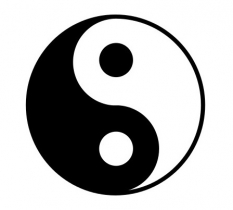By Sajeeb Sarker
Yin and Yang: The Taoist Philosophy of Life
Media School February 19, 2021

The duality of the binary opposites of Yin and Yang make life possible.
In Taoism (also spelled as Daoism), a Chinese religion and philosophy, the omnipresent Yin-Yang symbol explains the forces of life. According to Taoist beliefs, the Yin (the dark swirl) represents shadows, femininity, and the trough of a wave while the Yang (the light or white swirl) represents brightness, passion and growth.
In easy words, the Yin (the dark side) is coupled with everything negative, hard, cold, wet, and feminine. The Yang (the light side), on the other hand, is associated with everything positive, soft, warm, dry, and masculine.
Taoist belief is that we all have those forces in ourselves. We all contain the spirit of Yin and of Yang and we have to achieve a balance of both in our lives.
The Taijitu symbol of Yin-Yang depicts the balance between two opposites where each element is placed against its opposite element e.g. good against bad, or light against dark. In Taoist metaphysics, such dichotomous moral judgments cannot be distinguished separately, rather we have to understand them as an inseparable whole.
From this point of view, Yin and Yang can be considered as complementary forces rather than being opposing ones. This wholeness is sacred because they interact to form a dynamic system in which the whole is greater than the parts separately that actually create the wholeness.
Thus, the Yin and Yang acts as two halves that mutually form the wholeness of Qi, and ultimately the combination of the two energies makes life possible. Taoists believe that only when these energies are appropriately balanced between Yin and Yang, life flows smoothly while ensuring a good state of physical and emotional health.


